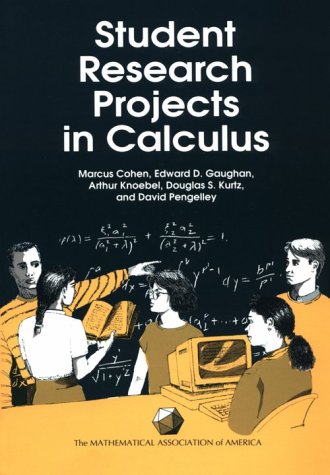Spectrum
1 total work
Student Research Projects in Calculus
by Marcus Cohen, Edward D. Gaughan, Arthur Knoebel, Douglas S Kurtz, and David Pengelley
Published 1 January 1992
Changing the way students learn calculus at New Mexico State University. In the Spring of 1988, Marcus Cohen, Edward D. Gaughan, Arthur Knoebel, Douglas S. Kurtz, and David Penegelley began work on a student project approach to calculus. For the next two years, most of their waking hours (and some of their dreams) would be devoted to writing projects for their students and discovering how to make the use of projects in calculus classes not only successful, but practical as well. A grant from the National Science Foundation made it possible for this experiment to go forward on a large scale. The enthusiasm of the original group of five faculty was contagious, and soon other members of the department were also writing and using projects in their calculus classes. At the present time, about 80% of the calculus students at New Mexico State University are doing projects in their Calculus courses. Teachers can use their methods in teaching their own calculus courses.
Student Research Projects in Calculus provides teachers with over 100 projects ready to assign to students in single and multivariable calculus. The authors have designed these projects with one goal in mind: to get students to think for themselves. Each project is a multistep, take-home problem, allowing students to work both individually and in groups. The projects resemble mini-research problems. Most of them require creative thought, and all of them engage the student's analytic and intuitive faculties. the projects often build from a specific example to the general case, and weave together ideas from many parts of the calculus. Project statements are clearly stated and contain a minimum of mathematical symbols. Students must draw their own diagrams, decide for themselves what the problem is about, and what toolsfrom the calculus they will use to solve it. This approach elicits from students an amazing level of sincere questioning, energetic research, dogged persistence, and conscientious communication. Each project has accompanying notes to the instructor, reporting students' experiences. The notes contain helpful information on prerequisites, list the main topics the project explores, and suggests helpful hints. The authors have also provided several introductory chapters to help instructors use projects successfully in their classes and begin to create their own.
Student Research Projects in Calculus provides teachers with over 100 projects ready to assign to students in single and multivariable calculus. The authors have designed these projects with one goal in mind: to get students to think for themselves. Each project is a multistep, take-home problem, allowing students to work both individually and in groups. The projects resemble mini-research problems. Most of them require creative thought, and all of them engage the student's analytic and intuitive faculties. the projects often build from a specific example to the general case, and weave together ideas from many parts of the calculus. Project statements are clearly stated and contain a minimum of mathematical symbols. Students must draw their own diagrams, decide for themselves what the problem is about, and what toolsfrom the calculus they will use to solve it. This approach elicits from students an amazing level of sincere questioning, energetic research, dogged persistence, and conscientious communication. Each project has accompanying notes to the instructor, reporting students' experiences. The notes contain helpful information on prerequisites, list the main topics the project explores, and suggests helpful hints. The authors have also provided several introductory chapters to help instructors use projects successfully in their classes and begin to create their own.
